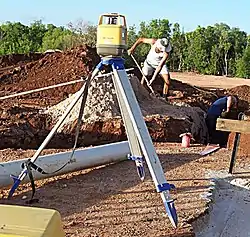Laser level
In surveying and construction, the laser level is a control tool consisting of a rotating laser beam projector that can be affixed to a tripod. The tool is leveled according to the accuracy of the device and projects a fixed red or green beam in a plane about the horizontal and/or vertical axis.[1]

Development
The concept of a laser level has been around since at least the early 1970s,[2] the original spinning-mirror design laser plane and line level was patented by the late 1980s,[3] and the compact lens-based laser line level (as produced by many tool manufacturers today) was patented in the late 1990s.[4]
Rotary laser level
A rotary laser level is a more advanced laser level in that it spins the beam of light fast enough to give the effect of a complete 360 degree horizontal or vertical plane, thus illuminating not just a fixed line, but a horizontal plane.[5] The laser beam projector employs a rotating head with a mirror for sweeping the laser beam about a vertical axis. If the mirror is not self-leveling, it is provided with visually readable level vials and manually adjustable screws for orienting the projector. A staff carried by the operator is equipped with a movable sensor, which can detect the laser beam and gives a signal when the sensor is in line with the beam (usually an audible beep). The position of the sensor on the graduated staff, also known as a grade rod, or story pole, allows comparison of elevations between different points on the terrain. Most laser levels are used in the construction industry.
Tower-mounted laser level
A tower-mounted laser level is used in combination with a sensor on a wheel tractor-scraper in the process of land laser leveling to bring land (for example, an agricultural field) to near-flatness with a slight grade for drainage.
Benefits[6]
References
- Blake, L. S. (22 October 2013). Civil Engineer's Reference Book. Elsevier. p. 6. ISBN 978-1-4831-0233-7.
- US patent 3897637
- US patent 4973158
- US patent 5836081, Steven J. Orosz, Jr., "Light beam leveling means and method", issued 1998-11-17, assigned to Schroeder, Charles F.
- J. Uren; W.F. Price (17 March 2010). Surveying for Engineers. Palgrave Macmillan. pp. 543–. ISBN 978-1-137-05279-7.
- "LASER LEVELING". dswcpunjab.gov.in. Retrieved 2017-08-03.
- "Laser Leveling". www.dswcpunjab.gov.in. Retrieved 2017-08-03.
- "LASER LEVELING". dswcpunjab.gov.in. Retrieved 2017-08-03.
External links
- Checking a level for accuracy
- US patent 4062634, Rando, Joseph F.; Kahn, Michael E. & Heumann, Thomas E. et al., "System for controlling attitude of laser beam plane", issued 1977-12-13, assigned to Spectra-Physics, Inc.
- Green Vs Red Laser Level